
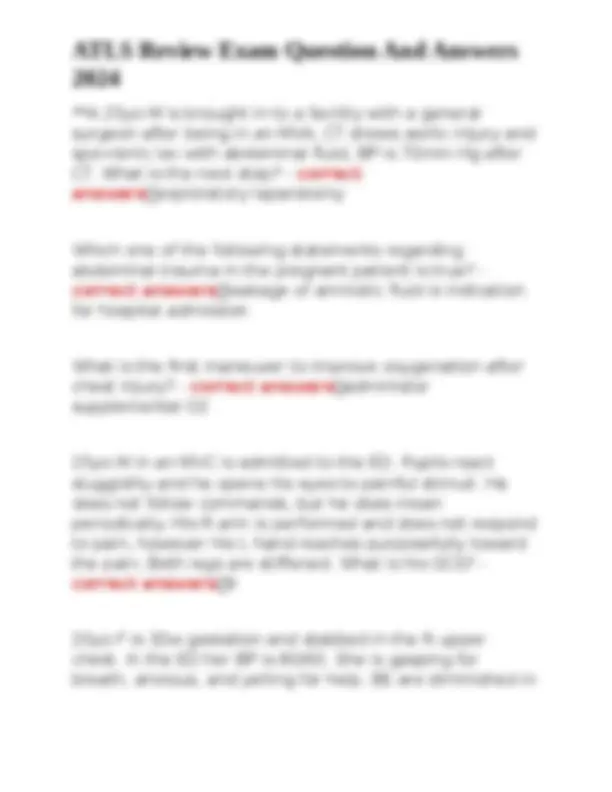
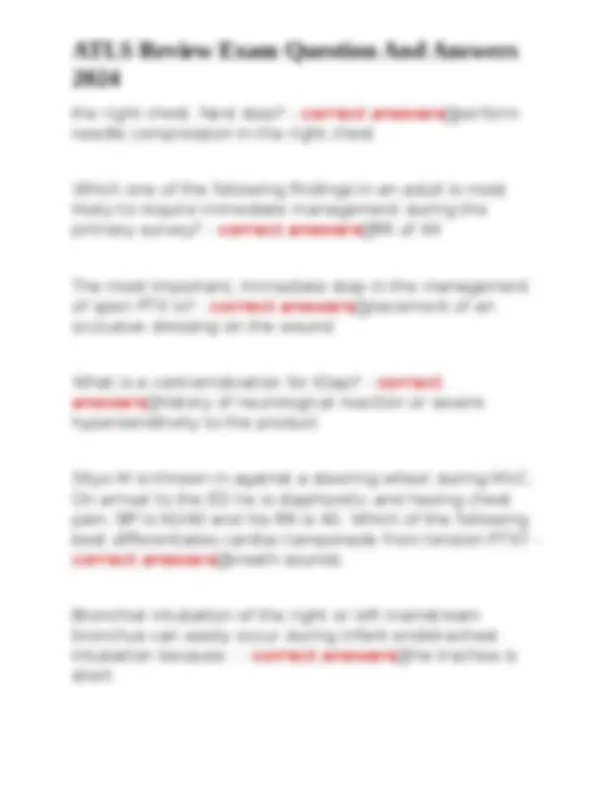
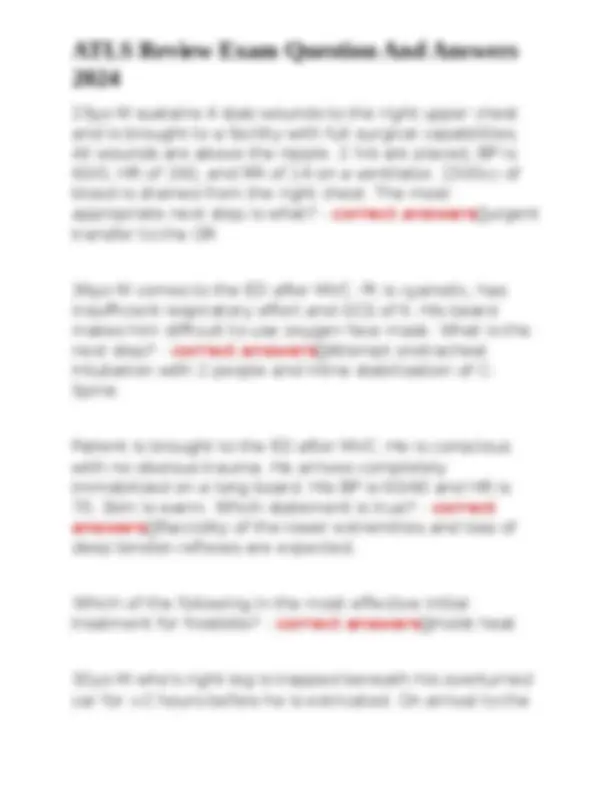
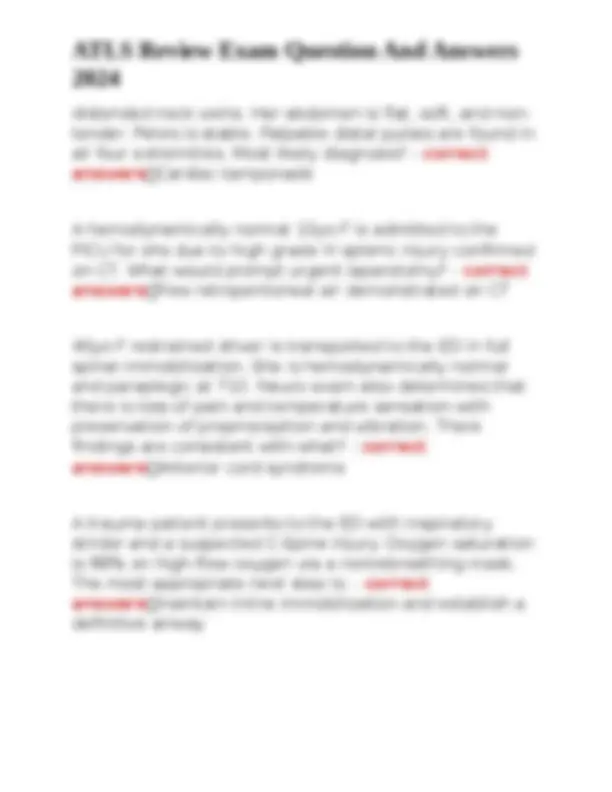
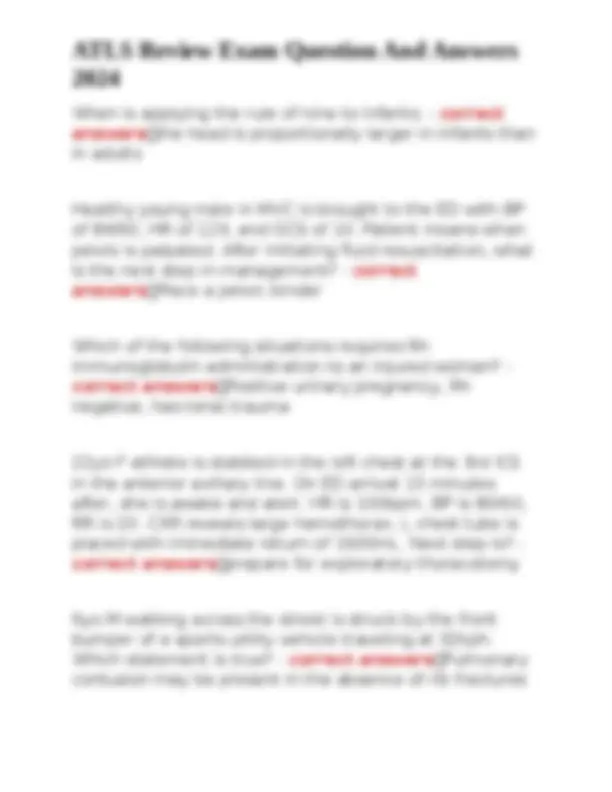
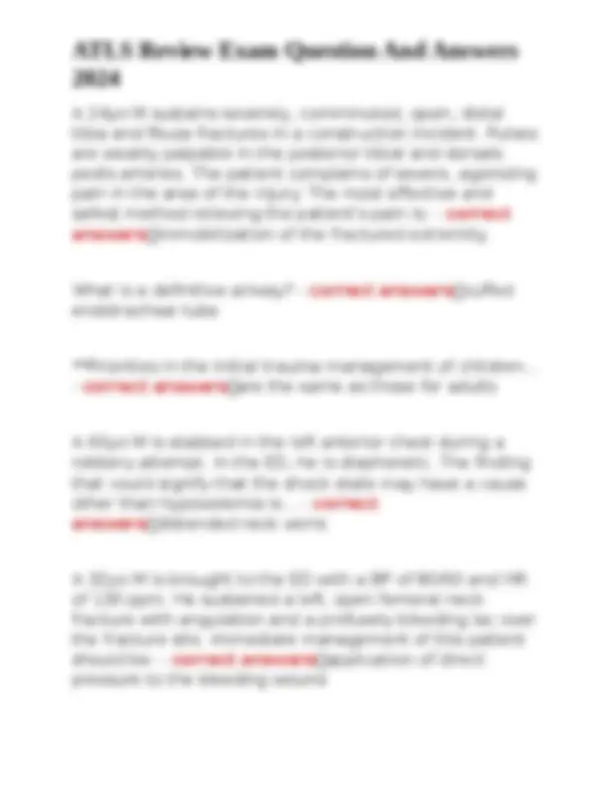
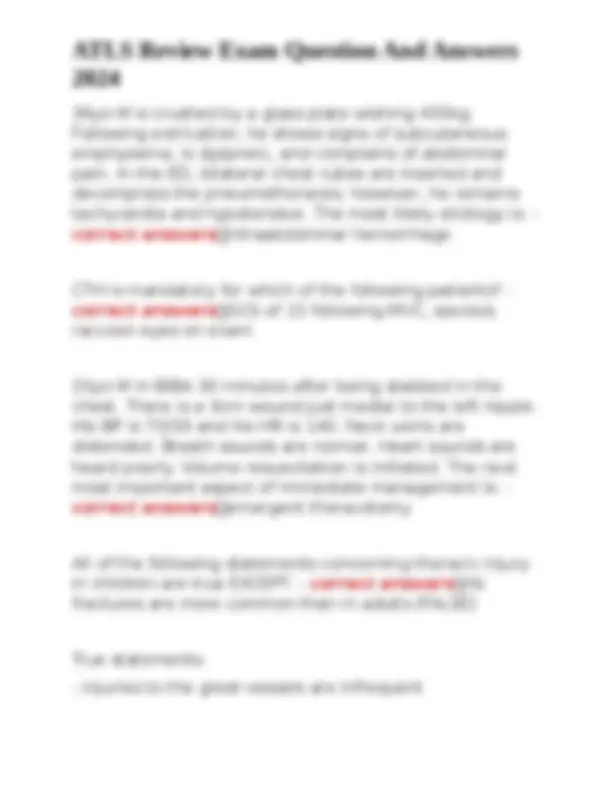
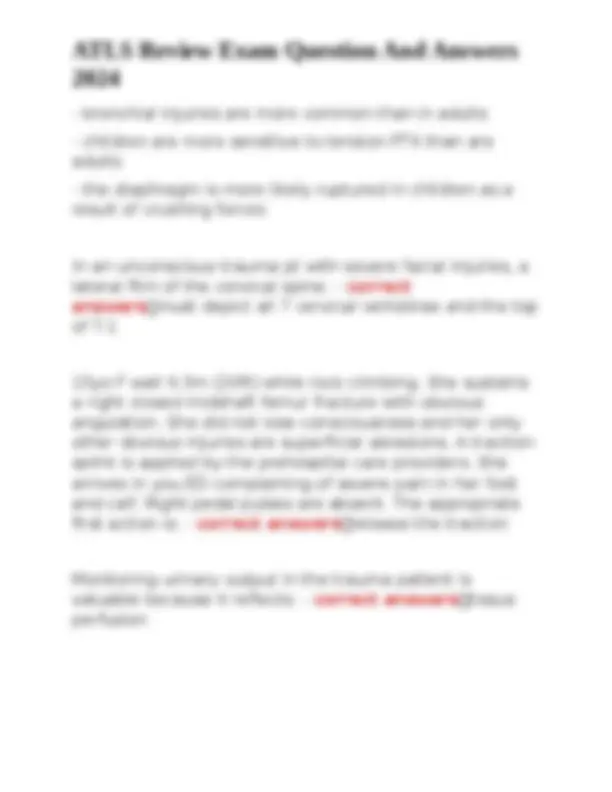
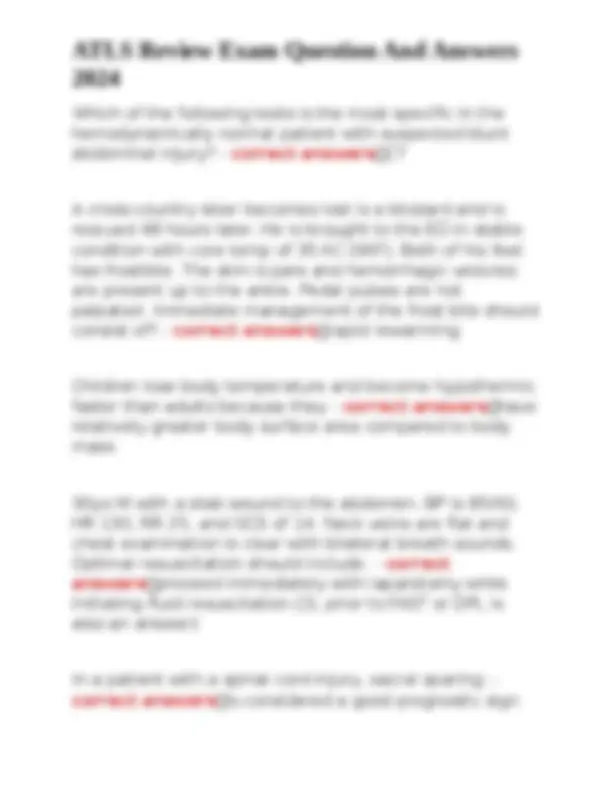
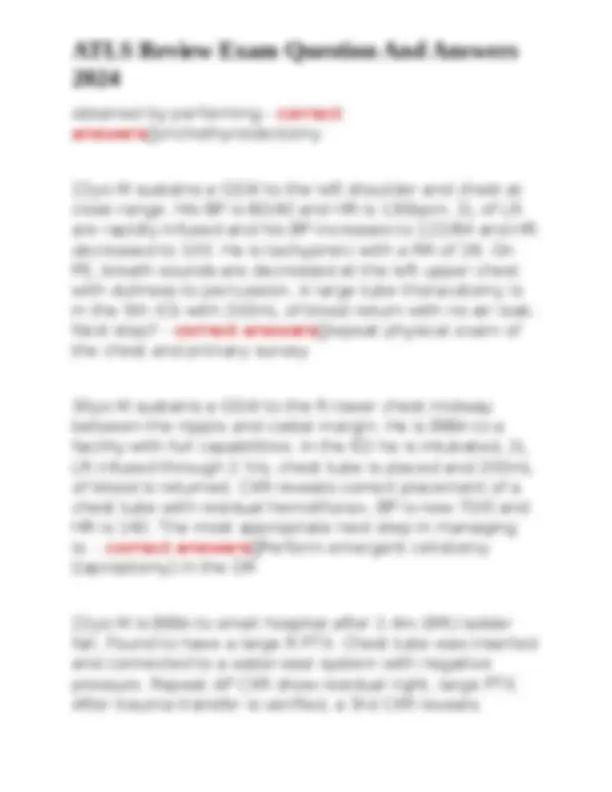
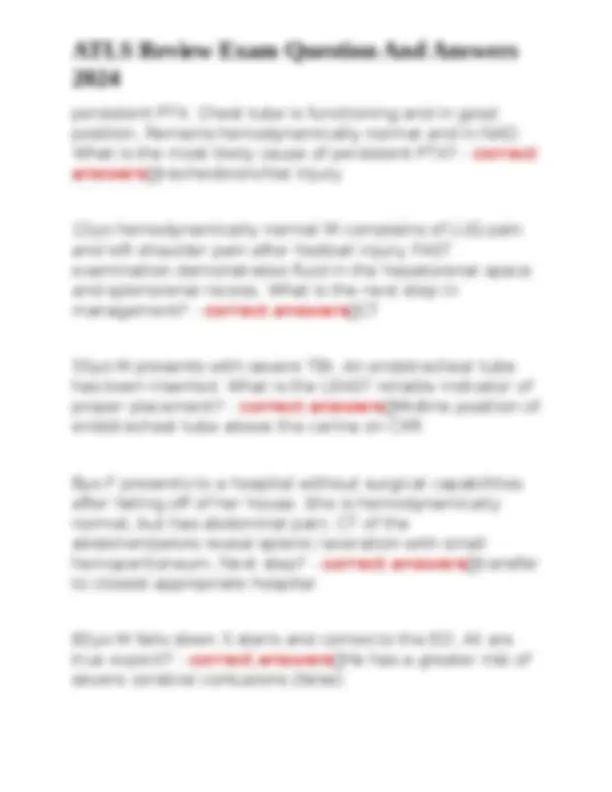



Study with the several resources on Docsity

Earn points by helping other students or get them with a premium plan


Prepare for your exams
Study with the several resources on Docsity

Earn points to download
Earn points by helping other students or get them with a premium plan
Community
Ask the community for help and clear up your study doubts
Discover the best universities in your country according to Docsity users
Free resources
Download our free guides on studying techniques, anxiety management strategies, and thesis advice from Docsity tutors
ATLS Review Exam Question And Answers 2024
Typology: Exams
1 / 20

This page cannot be seen from the preview
Don't miss anything!













A 22yo M is hypotensive and tachycardia after a shotgun wound to the L shoulder. His BP is initially 80/40. After 2L of fluids his BP increases to 122/84. HR is 100bpm and his RR is 28. Breath sounds are decreased in the left hemithorax, and a closed tube thoracotomy is performed with a small amount of blood return and no air leak. What is the next step? - correct answers ✅Reexamine the chest A construction worker falls 2 stories and suffers bilateral calcanea fractures. He now is having back pain. What would confirm diagnosis? - correct answers ✅Complete spine x-ray series What is the principle of balanced resuscitation? - correct answers ✅permissive hypotension and early plasma infusion In managing a head-injured patient, what is the most important initial step? - correct answers ✅Secure the airway A previously healthy 70kg man suffered ~2L of acute blood loss. Which appropriately applies to this patient? - correct answers ✅His systolic BP will be decreased with a narrowed pulse pressure
NOT his pulse pressure will be widened, urinary output at lower level of normal, tachy but no BP change, or maintained systolic BP with elevated diastolic BP The physiologic hypovolemia of pregnancy has clinical significance in the management of severely injured, gravid woman by: - correct answers ✅increasing the volume of blood to produce maternal hypotension The best assessment of fluid resuscitation of the burn patient is - correct answers ✅adequate urinary output The diagnosis of shock MUST include: - correct answers ✅evidence of inadequate organ perfusion A 7yo M is brought to the ED by his parents several minutes after falling through a window. He is bleeding from a 6cm wound on the medial right thigh. Immediate management of the wound should include? - correct answers ✅Direct pressure on the wound **For the patient with severe traumatic brain injury, around HYPOCARBIA (dec CO2) should be avoided in order to prevent what? - correct answers ✅cerebral vasoconstriction with diminished perfusion.
the right chest. Next step? - correct answers ✅perform needle compression in the right chest Which one of the following findings in an adult is most likely to require immediate management during the primary survey? - correct answers ✅RR of 44 The most important, immediate step in the management of open PTX is? - correct answers ✅placement of an occlusive dressing on the wound What is a contraindication for tDap? - correct answers ✅history of neurological reaction or severe hypersensitivity to the product 56yo M is thrown in against a steering wheel during MVC. On arrival to the ED he is diaphoretic and having chest pain. BP is 60/40 and his RR is 40. Which of the following best differentiates cardiac tamponade from tension PTX? - correct answers ✅breath sounds Bronchial intubation of the right or left mainstream bronchus can easily occur during infant endotracheal intubation because : - correct answers ✅the trachea is short
23yo M sustains 4 stab wounds to the right upper chest and is brought to a facility with full surgical capabilities. All wounds are above the nipple. 2 IVs are placed, BP is 60/0, HR of 160, and RR of 14 on a ventilator. 1500cc of blood is drained from the right chest. The most appropriate next step is what? - correct answers ✅urgent transfer to the OR 39yo M comes to the ED after MVC. Pt is cyanotic, has insufficient respiratory effort and GCS of 6. His beard makes him difficult to use oxygen face mask. What is the next step? - correct answers ✅Attempt orotracheal intubation with 2 people and inline stabilization of C- Spine Patient is brought to the ED after MVC. He is conscious with no obvious trauma. He arrives completely immobilized on a long board. His BP is 60/40 and HR is
through 4, but no pneumothorax. After 2L, his BP is 110/74 and HR is 100, RR is 18. He has gross hematuria and a pelvic fracture. The facility is 128km away. Before you transfer, what should you do? - correct answers ✅call the receiving hospital and speak to the trauma surgeon. Hemorrhage of 20% of the patient's blood is usually associated with... - correct answers ✅tachycardia Which one of the following statement concerning intraosseous infusion is TRUE? - correct answers ✅aspiration of bone marrow confirms appropriate positioning of the needle A young woman sustains a severe head injury as the result of a MVC. In the ED her GCS is 6, BP 140/90, HR 80bpm. She is intubated and mechanically ventilated. Her pupils are 3mm in size and equally reactive to light. There is no other apparent injury. The most important principle to follow in the early management of her head injury is to: - correct answers ✅Avoid hypotension 33yo F involved in an MVC. It took 30 minutes to extricate her from the car. Upon arrival, her HR is 120bpm, BP is 90/70, RR is 16, and HCS is 15. On exam there are equal breath sounds, anterior chest wall ecchymosis, and
distended neck veins. Her abdomen is flat, soft, and non- tender. Pelvis is stable. Palpable distal pulses are found in all four extremities. Most likely diagnosis? - correct answers ✅Cardiac tamponade A hemodynamically normal 10yo F is admitted to the PICU for ohs due to high grade III splenic injury confirmed on CT. What would prompt urgent laparotomy? - correct answers ✅Free retroperitoneal air demonstrated on CT 40yo F restrained driver is transported to the ED in full spinal immobilization. She is hemodynamically normal and paraplegic at T10. Neuro exam also determines that there is loss of pain and temperature sensation with preservation of proprioception and vibration. There findings are consistent with what? - correct answers ✅Anterior cord syndrome A trauma patient presents to the ED with inspiratory stridor and a suspected C-Spine injury. Oxygen saturation is 88% on high-flow oxygen via a nonrebreathing mask. The most appropriate next step is: - correct answers ✅maintain inline immobilization and establish a definitive airway
A 24yo M sustains severely, comminuted, open, distal tibia and fibula fractures in a construction incident. Pulses are weakly palpable in the posterior tibial and dorsals pedis arteries. The patient complains of severe, agonizing pain in the area of the injury. The most effective and safest method relieving the patient's pain is: - correct answers ✅immobilization of the fractured extremity. What is a definitive airway? - correct answers ✅cuffed endotracheal tube **Priorities in the initial trauma management of children...
The extent of hypoxemia resulting from a flail chest is primarily due to: - correct answers ✅underlying lung contusion The most important determinant of fetal outcome in the traumatized pregnant patient is: - correct answers ✅hemodynamic status of the mother A motorcycle rider loses control of his bike and tumbles down an embankment. After full spinal immobilization, he is brought to the ED. The patient is unresponsive, demonstrates cerebral posturing to painful stimuli, and does not open his eyes. BP. is 158.94, HR is 66, and RR is
39yo M is crushed by a glass plate wishing 450kg. Following extrication, he shows signs of subcutaneous emphysema, is dyspneic, and complains of abdominal pain. In the ED, bilateral chest rubes are inserted and decompress the pneumothoraces; however, he remains tachycardia and hypotensive. The most likely etiology is: - correct answers ✅intraabdominal hemorrhage CTH is mandatory for which of the following patients? - correct answers ✅GCS of 15 following MVC, ejected, raccoon eyes on exam 20yo M in BIBA 30 minutes after being stabbed in the chest. There is a 3cm wound just medial to the left nipple. His BP is 70/33 and his HR is 140. Neck veins are distended. Breath sounds are normal. Heart sounds are heard poorly. Volume resuscitation is initiated. The next most important aspect of immediate management is: - correct answers ✅emergent thoracotomy All of the following statements concerning thoracic injury in children are true EXCEPT: - correct answers ✅rib fractures are more common than in adults (FALSE) True statements:
29yo F arrives in the ED after being involved in a MVC. She is 30 weeks pregnant. She was restrained, and an airbag was deployed. The following statement best describes the risk of injury: - correct answers ✅The use of premature fetal delivery and death is reduced by the use of restraints a 35yo F sustains multiple injuries in a MVC and is transported to a small rural hospital in full spinal protection. She has a GCS score of 4 and is being mechanically ventilated. Intravenous access and warmed crystalloid solution infusion are established. She remains hemodynamically normal and full spinal protection is maintained. Preparations are made to transfer her to another facility for definitive neurosurgical care. Prior to transport by air, which of the following is mandatory? - correct answers ✅CXR A patient is admitted to the ED after a fall from ~12m (40ft). He complains of neck and abdominal pain. Primary survey is completed and patient's vital signs have been and are normal, except for a transient drop in SBP to 90. His pressure responded to infusion of warm saline. DPL is performed and is grossly positive for blood. Lateral C- Spine film is normal, but AP and odontoid films have not been obtained. The patient's possible neck injury should be managed by: - correct answers ✅maintaining inline
immobilization of the neck and proceeding with celiotomy (laparotomy) Middle aged man sustains multiple injuries in a single car crash and is taken to a community hospital. He is hemodynamically normal, but has a obvious multiple facial lacerations and fractures. His breath sounds are slightly decreased over the right hemothorac, but he is in no respiratory distress. His abdomen is soft and active BS are osculated. His GCS score is 7. A CXR demonstrates a widened mediastinum. Surgical specialty capabilities are not available at this hospital, and the nearest trauma center is 64km (40 miles). Initial management should be:
persistent PTX. Chest tube is functioning and in good position. Remains hemodynamically normal and in NAD. What is the most likely cause of persistent PTX? - correct answers ✅tracheobronchial injury 12yo hemodynamically normal M complains of LUQ pain and left shoulder pain after football injury. FAST examination demonstrates fluid in the hepatorenal space and splenorenal recess. What is the next step in management? - correct answers ✅CT 55yo M presents with severe TBI. An endotracheal tube has been inserted. What is the LEAST reliable indicator of proper placement? - correct answers ✅Midline position of endotracheal tube above the carina on CXR 8yo F presents to a hospital without surgical capabilities after falling off of her house. She is hemodynamically normal, but has abdominal pain. CT of the abdomen/pelvis reveal splenic laceration with small hemoperitoneum. Next step? - correct answers ✅transfer to closest appropriate hospital 82yo M falls down 5 stairs and comes to the ED. All are true expect? - correct answers ✅He has a greater risk of severe cerebral contusions (false)
14yo M is injured with a propane tank explosion and he is thrown 5m (16ft) against a tree. He arrives in the ED with a BP of 80/45, HR 100, RR of 32. He has reddened skin on his face and exposed extremities, but his clothes are not burned. He is gasping and says that he cannot breathe. His neck veins are distended. Most likely cause of hypotension is? - correct answers ✅tension pneumothorax